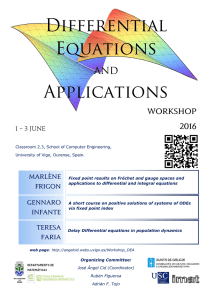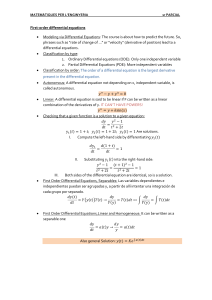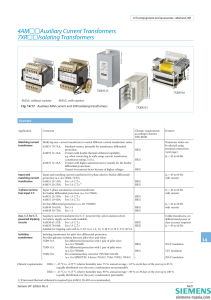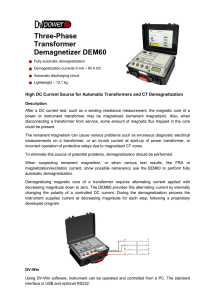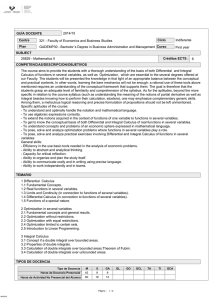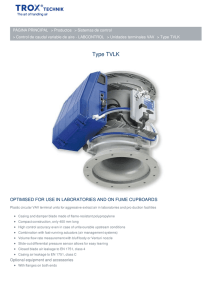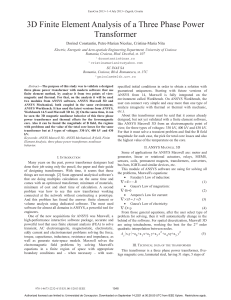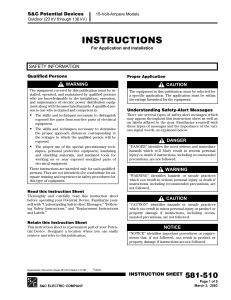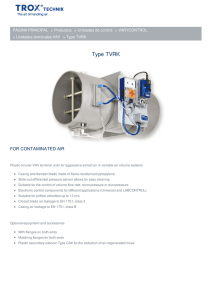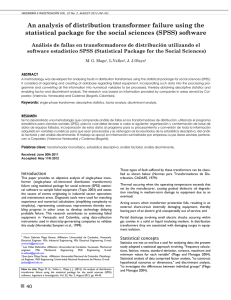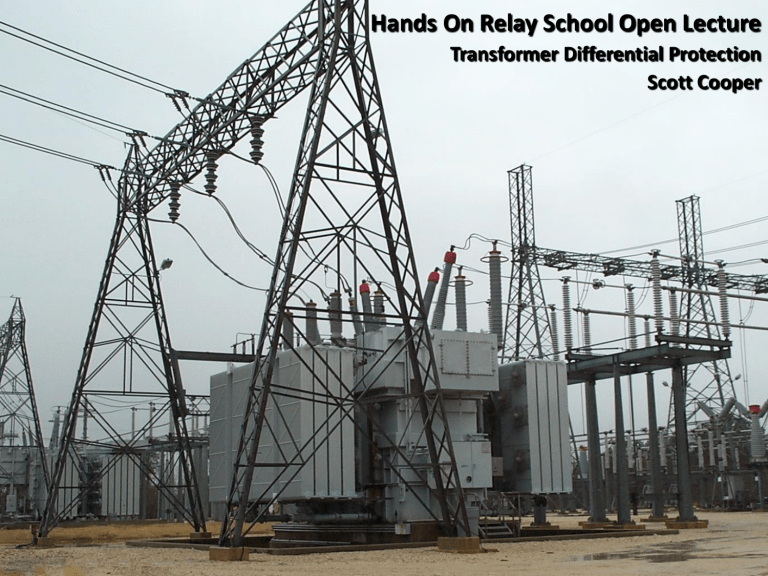
Hands On Relay School Open Lecture Transformer Differential Protection Scott Cooper Transformer Differential Protection • Introduction: • Transformer differential protection schemes are ubiquitous to almost any power system. • While the basic premise of transformer differential protection is straightforward, numerous features must be employed to compensate for challenges presented by the transformer application…. Challenges to Transformer Differential Protection • Current Mismatch Caused by the Transformation Ratio and Differing CT Ratios • Current Mismatch Caused by Differing CT Ratios • Delta-Wye Transformation of Currents • Zero Sequence Elimination • LTC Induced Mismatch, CT Saturation, CT Remanence, and CT Tolerance • Inrush Phenomena and Harmonic Content Availability • Over Excitation Phenomena • Switch Onto Fault concerns Challenges to Understanding Transformer Differential Protection • Current Mismatch Caused by the Transformation Ratio and Differing CT Ratios • Current Mismatch Caused by Differing CT Ratios • Delta-Wye Transformation of Currents • Zero Sequence Elimination • LTC Induced Mismatch, CT Saturation, CT Remanence, and CT Tolerance • Inrush Phenomena and Harmonic Content Availability • Over Excitation Phenomena • Switch Onto Fault concerns Current Mismatch Caused by the Transformation Ratio and Differing CT Ratios Kirchhoff’s Current Law: At any node, the sum of currents flowing into that node is equal to the sum of currents flowing out of that node (fig 1). I1 + I2 + I3 = 0 I1 Node I3 I2 Current Mismatch Caused by the Transformation Ratio and Differing CT Ratios Because of the transformation ratio and probable CT ratio mismatch, transformer winding currents cannot be directly compared, but the MVA on each side can be compared. MVA1 + MVA2 + MVA3 = 0 I1 + I2 + I3 = 0 I1 Node MVA1 I2 Transformer I3 MVA3 MVA2 Current Mismatch Caused by the Transformation Ratio and Differing CT Ratios To calculate the secondary current equal to one per unit, the following calculations are used on each side of the transformer: For wye-connected CT’s: For delta-connected CT’s: WindingTap WindingTap TransformerVA VL L CTR * 3 TransformerVA 3 VL L CTR * 3 Current Mismatch Caused by the Transformation Ratio and Differing CT Ratios During testing, the desired starting current values is determined by multiplying the desired per unit current by the tap to find the equivalent secondary current for each side. PU desired WindingTap I test To convert a measured trip current to a per unit current, divide the current by the tap for that winding. PU measured I measured WindingTap Challenges to Understanding Transformer Differential Protection • Current Mismatch Caused the Transformation Ratio and by Differing CT Ratios • Delta-Wye Transformation of Currents • Zero Sequence Elimination • LTC Induced Mismatch, CT Saturation, CT Remanence, and CT Tolerance • Inrush Phenomena and Harmonic Content Availability • Over Excitation Phenomena • Switch Onto Fault concerns Delta-Wye Transformation of Currents • Transformers frequently employ Delta-Wye connections I A IB Primary Winding A • Not only do these connections introduce a 30 degree phase shift, but they also change the makeup of the currents measured by the CT’s • For differential schemes, the current 𝐼ഥ𝐴 -𝐼ഥ𝐵 cannot be directly compared to current 𝐼ഥ𝑎 I a I b I c Secondary Winding a I B IC WB Wb IC I A WC Wc Delta-Wye Transformation of Currents I A IB I Primary Winding A For Single phase differential relays like the HU, BDD, and CA, the solution for delta-wye transformers is to simply connect the Winding 2 CT secondary circuits in a delta to match the primary main windings. Secondary Winding a I B IC I WB Wb IC I A I WC Wc Differential A Differential B Differential C c b a AB connected delta-wye transformer Ia-Ib Ia Ia Ia Ib-Ic Ib Ib Ib Ic-Ia Ic Ic Ic-Ia Ic Ic Ia-Ib Ia Ib Ib-Ic Iab AB connected delta-wye transformer • Subtracting Vectors: Subtract from reference phase vector the connected non-polarity vector…in our example Ia-Ib c -b a a b • • A-B -b c b Can be repeated for B & C, or you can assume –120 and –240 displacement from A for B&C respectively Ib – Ic and Ic – Ia would be the vectors AC connected delta-wye transformer Ia-Ic Ia Ic-Ib Ia Ia Ib-Ia Ic Ib Ib Ib Ia Ic-Ib Ic Ib-Ia Ic Ic Ib Ia-Ic AC connected delta-wye transformer • Subtracting vectors: Subtract from reference phase vector the connected nonpolarity vector…in our example Ia+(-Ic) or Ia-Ic c c a b • • -c a b -c A-C Can be repeated for B & C, or you can assume –120 and –240 displacement from A for B&C respectively Ib – Ia and Ic – Ib would be the vectors Delta-Wye Transformation of Currents Angular Displacement Conventions: • ANSI: Remember “High Leads Low by 30” – Y-Y, - @ 0°; Y- , -Y @ X1 lags H1 by 30° – ANSI makes life easy 0 11 1 2 10 9 3 8 4 7 6 5 Dy1 = X1 lags H1 by 1*30 = 30, or H1 leads X1 by 30 (ANSI std.) Delta-Wye Transformation of Currents Angular Displacement Conventions: • IEC connection designations: – 1st Letter is H side bushing connection – 2nd letter is x-side bushing connection – Number is the number of 30 increments the X-side LAGS the H-side • Dy11=X1 lags H1 by 11*30°=330° • Think of a clock – each hour is 30 degrees 0 11 1 2 10 9 3 8 4 7 6 5 Dy1 = X1 lags H1 by 1*30 = 30, or H1 leads X1 by 30 (ANSI std.) Delta-Wye Transformation of Currents There are also several transformer relay manufacturer conventions commonly used for defining the transformer connections. The following are examples for ABC rotation except where noted: • SEL 387 Method: In this convention each winding is given a number 0-11, which corresponds to the number of 30 degree leading angle increments. Each winding is corrected back to zero degrees. • Beckwith 3311 Custom Method: In this convention each winding is given a number 0-11, which corresponds to the number of 30 degree lagging angle increments relative of a hypothetical wye winding. Winding correction mostly mimics old connection compensation schemes. • GE T60 Method: In this convention each winding is given an angle which corresponds to the lagging angle relative to the designated reference winding. Delta-Wye Transformation of Currents So what does all this mean while testing? Here is a list of common relays, common connections, and test angles (assuming set to positive angles lead): W1 W2 IEC Beckwith Custom W1 W2 SEL GE (Ref W1) W1 Test Angles (ABC Rotation) W2 W1-A W1-B W1-C W2-A W2-B W2-C Y Y Yy0 0 0 Yy0 12 12 0 -120 120 180 -60 60 DAB Y Dy1 11 1 Dy30 1 12 30 -90 150 180 -60 60 Y DAB Yd11 0 11 Yd330 12 1 0 -120 120 -150 -30 90 DAC Y Dy11 1 0 Dy330 11 12 -30 -150 90 180 -60 60 Y DAC Yd1 0 1 YD30 12 11 0 -120 120 150 30 -90 DAC DAC Dd0 1 1 Dd0 11 11 -30 -150 90 150 30 -90 DAB DAB Dd0 11 11 Dd0 1 1 30 -90 150 -150 -30 90 DAC DAB Dd10 1 11 Dd300 11 1 -30 -150 90 -150 -30 90 DAB DAC Dd2 11 1 Dd60 1 11 30 -90 150 150 30 -90 Challenges to Understanding Transformer Differential Protection • Current Mismatch Caused the Transformation Ratio and by Differing CT Ratios • Delta-Wye Transformation of Currents • Zero Sequence Elimination • LTC Induced Mismatch, CT Saturation, CT Remanence, and CT Tolerance • Inrush Phenomena and Harmonic Content Availability • Over Excitation Phenomena • Switch Onto Fault concerns Zero Sequence Elimination • In all wye connected windings, the ground provides a way for current to enter the differential zone without being measured by a phase differential CT. • This can unbalance the differential during external phase to neutral faults. • If the differential protection is to resist improperly tripping for external faults, this current has to be removed from differential calculations. I A IB Primary Winding A I a I b I c Secondary Winding a I B IC WB Wb IC I A WC Wc Zero Sequence Elimination I A IB The first removal method is to simply connect the CT secondary circuit in delta. I Primary Winding A Secondary Winding a I B IC I WB Wb IC I A This straightforward method is used in electromechanical and in some digital relay retrofit differential applications. I WC Wc Differential A Differential B Differential C c b a Zero Sequence Elimination • In digital applications with wye connected CT secondary circuits, the ground current has to be removed numerically. • This is done by either converting the currents to delta quantities or by directly subtracting calculated zero sequence current from the differential quantity. Challenges to Understanding Transformer Differential Protection • Current Mismatch Caused the Transformation Ratio and by Differing CT Ratios • Delta-Wye Transformation of Currents • Zero Sequence Elimination • LTC Induced Mismatch, CT Saturation, CT Remanence, and CT Tolerance • Inrush Phenomena and Harmonic Content Availability • Over Excitation Phenomena • Switch Onto Fault concerns e2 Slo p • The X-axis is the Restraint Current • Measure of current through the transformer after compensation • As restraint current increases, differential relay sensitivity is decreased • Relay manufacturers use a variety of calculations like the maximum, sum or average of the winding currents • The Y-axis is the Differential/Operate current • Is the sum of all winding currents after amplitude and angle compensation Differential/Operate Current LTC Induced Mismatch, CT Saturation, CT Remanence, and CT Tolerance Trip Region p Slo e1 MPU Restraint Current • e2 • The Minimum Pickup region is used between zero and approximately 0.5 per unit restraint current. It provides security against CT remanence and accuracy errors and is usually set between 0.3 and 0.5pu. The Slope 1 region is used between the minimum pickup region and the slope 2 breakpoint. Slope 1 provides security against false tripping due to CT accuracy. Class C CT accuracy is +/-10%, therefore 20% should be the absolute minimum setting with greater than 30% preferred. For LTC applications, another +/-10% is added. The Slope 2 region is used above the slope 2 breakpoint, which is normally set at 2pu. Slope 2 provides security against false tripping during through fault events where CT saturation is likely. Above 2pu restrainint current, a significant DC current component will be present and therefore saturation is likely. Slope 2 is normally set at 60-80%. Slo p • Differential/Operate Current LTC Induced Mismatch, CT Saturation, CT Remanence, and CT Tolerance Trip Region p Slo e1 MPU Restraint Current LTC Induced Mismatch, CT Saturation, CT Remanence, and CT Tolerance • SEL 487 Implementation: LTC Induced Mismatch, CT Saturation, CT Remanence, and CT Tolerance • SEL 487 Implementation: LTC Induced Mismatch, CT Saturation, CT Remanence, and CT Tolerance • • Set Prefault >DIRTR and <DIOPR for 0.025sec prior to each shot. Monitor CON(A) for high security mode Challenges to Transformer Differential Protection • Current Mismatch Caused the Transformation Ratio and by Differing CT Ratios • Delta-Wye Transformation of Currents • Zero Sequence Elimination • LTC Induced Mismatch, CT Saturation, CT Remanence, and CT Tolerance • Inrush Phenomena and Harmonic Content Availability • Over Excitation Phenomena • Switch Onto Fault concerns Inrush Phenomena and Harmonic Content Availability When a transformer is energized, a step change in magnetizing voltage occurs. This step change in magnetizing voltage results in over fluxing the transformer core, causing magnetizing currents of up to 10pu. Inrush Phenomena and Harmonic Content Availability During inrush, transformers also generate significant amounts of even harmonics. These even harmonics can be used to prevent undesired differential relay operation by restraining the differential if the even harmonic content is above a preset level. Challenges to Transformer Differential Protection • Current Mismatch Caused the Transformation Ratio and by Differing CT Ratios • Delta-Wye Transformation of Currents • Zero Sequence Elimination • LTC Induced Mismatch, CT Saturation, CT Remanence, and CT Tolerance • Inrush Phenomena and Harmonic Content Availability • Over Excitation Phenomena • Switch Onto Fault concerns Over Excitation Phenomena Over excitation occurs whenever the transformer voltage is too high for the frequency. Over excitation is expressed as a percentage: 𝑉𝑡𝑟𝑎𝑛𝑠𝑓𝑜𝑟𝑚𝑒𝑟 𝐹𝑡𝑟𝑎𝑛𝑠𝑓𝑜𝑟𝑚𝑒𝑟 ൘ × 100 = 𝑃𝑒𝑟𝑐𝑒𝑛𝑡 𝑂𝑣𝑒𝑟 𝐸𝑥𝑐𝑖𝑡𝑎𝑡𝑖𝑜𝑛 𝑉𝑛𝑜𝑚𝑖𝑛𝑎𝑙 𝐹𝑛𝑜𝑚𝑖𝑛𝑎𝑙 Transformers are normally rated for at least 105% over excitation. Levels above this can damage the transformer. Over Excitation Phenomena As percent over excitation increases, magnetizing current will increase. Without appropriate logic, this can lead misoperation of the differential scheme ahead of dedicated V/Hz relays. Over Excitation Phenomena This additional magnetizing current is rich in 5th harmonic current. This plot shows the same fault record filtered for 5th harmonic content. e2 Slo p Modern digital relays have logic that increases the differential elements minimum pickup setting if significant 5th harmonic current is detected Differential/Operate Current Over Excitation Phenomena Trip Region 5th Harmonic Pickup p Slo e1 MPU Restraint Current Challenges to Transformer Differential Protection • Current Mismatch Caused the Transformation Ratio and by Differing CT Ratios • Delta-Wye Transformation of Currents • Zero Sequence Elimination • LTC Induced Mismatch, CT Saturation, CT Remanence, and CT Tolerance • Inrush Phenomena and Harmonic Content Availability • Over Excitation Phenomena • Switch Onto Fault concerns Switch Onto Fault concerns If a transformer experiences an internal fault on energization, the harmonic restraint feature on a restrained differential could delay tripping. Therefore relays commonly employ a secondary, unrestrained differential element. • This element must be set above the maximum expected inrush current, normally 8-12pu. Switch Onto Fault concerns In GE BDD and or Westinghouse HU types, an instantaneous overcurrent unit in series with the differential provides this feature. In digital relays, a separate setpoint is provided. To test these elements, parallel current channels as necessary and apply currents to one side of the differential. Understanding Transformer Differential Protection Questions?? J. Scott Cooper OMICRON [email protected]
